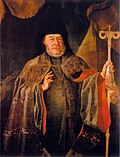Archbishop of Peć and Serbian Patriarch | |
|---|---|
| Archbishopric | |
| Eastern Orthodox | |
 | |
| Incumbent: Porfirije since 19 February 2021 | |
| Style | His Holiness |
| Location | |
| Ecclesiastical province | Belgrade and Karlovci |
| Residence | Palace of the Patriarchate, Belgrade |
| Information | |
| First holder | Sava (Archbishop) Joanikije II (Patriarch) |
| Established | 1219 (Archbishopric) 1346 and 1920 (Patriarchate) |
| Website | |
| spc | |
This is a list of heads of the Serbian Orthodox Church, since the establishment of the church as an autocephalous archbishopric in 1219 to today's patriarchate. The list includes all the archbishops and patriarchs that led the Serbian Orthodox Church under the Serbian Archbishopric and Serbian Patriarchate of Peć. Today, the church is unified under a patriarch who is officially styled as Archbishop of Peć, Metropolitan of Belgrade and Karlovci, and Serbian Patriarch (Serbian : Архиепископ пећки, митрополит београдско-карловачки, и патријарх српски, romanized: Arhiepiskop pećki, mitropolit beogradsko-karlovački, i patrijarh srpski).
Contents
- Styles
- Legend
- Archbishops, 1219–1346
- Patriarchs, 1346–1766
- Patriarchs, 1920–present
- Timeline
- See also
- Annotations
- References
- Sources
- External links
According to the current constitution of the Serbian Orthodox Church, the patriarch is elected by a special convocation of the Bishops' Council, [1] and serves as the chairman of the Holy Synod. [2]
The current patriarch is Porfirije, elected on 18 February 2021. [3] [4] He acceded to this position the next day, following his enthronement in the St. Michael's Cathedral in Belgrade. [5] [6] Porfirije was formally enthroned to the ancient throne of the Serbian patriarchs in the Patriarchal Monastery of Peć on 14 October 2022. [7] [8]
The autocephalous Serbian Archbishopric was founded in 1219 by Sava, under the authority of the ecumenical patriarch of Constantinople. In 1346, when Stefan Dušan proclaimed himself emperor, he also elevated the archiepiscopal see of Peć to the rank of a patriarchate, creating the Serbian Patriarchate of Peć. This was only recognized by the Ecumenical Patriarchate of Constantinople in 1375.
After the Ottoman conquest of the Serbian Despotate in 1459, the patriarchate gradually lost its importance. At times the church was forced by the Ottoman government to install Greeks in the office. From 1766 to 1920 the patriarchate was abolished and all ecclesiastical jurisdiction was given to the patriarch of Constantinople. A metropolitan see was maintained in Belgrade from 1766 afterwards. There were also independent Serbian Orthodox sees based in Karlovci and in Montenegro.
In 1920, the church was reunified and the patriarchy was reestablished with the see moving to Belgrade, but retaining the lineage of the throne of Saint Sava in Peć. The patriarch holds ecclesiastical authority over the Orthodox Church in the territory of the former Yugoslavia (with the exception of Macedonia), and also over the Serbian Orthodox diaspora in Western Europe, Australia, and the Americas.


























